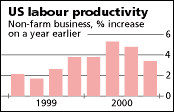
Will
America’s
“new economy” survive the downturn?
 |
IN JUDGING an economy’s prospects, what is the most important measure? Growth in GDP? Inflation? The size of the budget surplus? The level of the stockmarket? None of the above. Far more important is growth in productivity, which is crucial in itself and which affects all of those things and more. The surge in productivity in recent years has been a key element in America’s virtuous economic circle. Faster growth in productivity allowed faster growth in GDP with low inflation. This, in turn, boosted profits and share prices and encouraged more investment, which further lifted productivity. Whether or not firms can sustain their faster productivity gains is, therefore, a far more important question than when the Fed will next cut interest rates.
New figures this week showed that growth in America’s labour productivity slowed to an annualised 2.4% in the fourth quarter of last year (the year-on-year increase slowed to 3.4%, from 5.3% in the second quarter). This implies an acceleration in unit labour costs, which are now rising at an annual rate of more than 4%, up from zero six months ago. This will dent profits and might yet limit the Fed’s room to cut interest rates. But what do the new figures say about the long-term rate of productivity growth? Productivity growth surged to an annual average of 3% in 1996-2000, compared with 1.4% in 1973-95, but economists remain divided about whether this can last. The leading sceptic, Robert Gordon, an economist at Northwestern University, has argued that most of the increase in productivity growth outside information-technology industries has been cyclical, the result of the economic boom. In contrast, the Clinton administration’s last “Economic Report of the President” claimed that virtually all of the increase since 1995 has been “structural”.
Optimists
accept that productivity growth will temporarily dip in a downturn, but
they expect the trend of rapid growth to persist. Sceptics expect
productivity
growth to slump. One quarter’s figure cannot settle the matter. The
increase
in productivity in the fourth quarter was stronger than expected, given
that growth in GDP slowed so sharply. But the slowdown in productivity
growth even before the economy has moved into recession does cast some
doubt on how much of the previous increase is lasting. It is hard to
believe
that none of the jump in average productivity growth since 1995 was
cyclical.
During that period unemployment fell and the current-account deficit
tripled,
suggesting that output was growing faster than the economy’s productive
potential.
Teaching
a new economy old tricks How
productivity holds up will depend partly on how firms adjust investment
and jobs to a slowdown (see article). In the
“new
economy”, firms are supposed to behave differently. For instance, it
used
to be argued that IT investment would be relatively immune to the
cycle.
In fact, firms are already cutting their spending plans. Total business
investment fell in the fourth quarter for the first time in nine years.
Companies, equipped with fancy computer systems and instant information, were also supposed to be able to avoid an excessive build-up in inventories. Yet, as sales have slowed, stocks have continued to grow rapidly. Computerised systems have allowed firms to reduce their stocks, but have not eliminated big swings. Stocks have risen sharply over the past year, by more than at any time since the recession of the early 1990s, making cuts in production inevitable. In the past, firms have also been slow to shed workers during the early stages of a downturn, causing productivity to slump. In the new, more flexible economy, it is argued, firms can cut labour more swiftly. So far, firms have mainly trimmed working hours, not jobs. The snag is that this fails to cut fixed costs.
With profits already falling, firms will be forced to cut inventories, investment plans and workers. Optimists still maintain that IT and more timely information will help firms to adjust swiftly and so help to smooth the cycle. But the paradox is that the more swiftly they do this in a bid to improve their individual performance, the deeper will be the drop in output and profits in the economy as a whole.
That many “new economy” claims look flawed does not necessarily mean that all are. There is evidence that structural productivity growth has quickened, but not as much as is widely believed. Those who think that productivity growth of 3% or more is sustainable are saying that IT will have a bigger economic impact than the era of electricity and cars in the 1920s. That was, and remains, a bold claim.